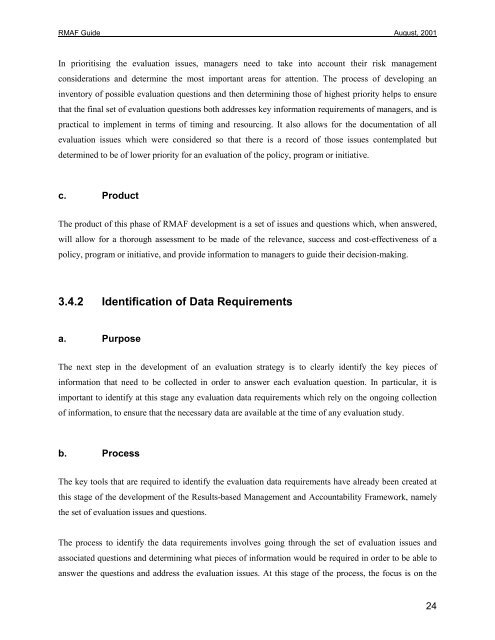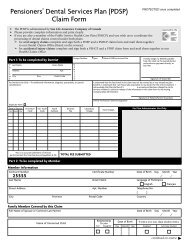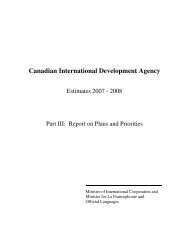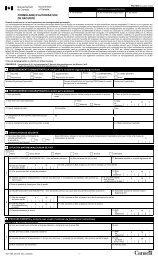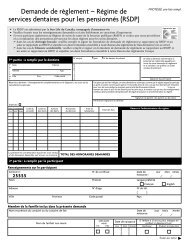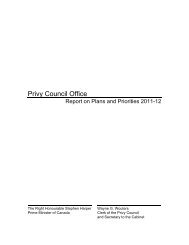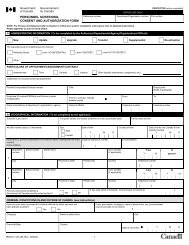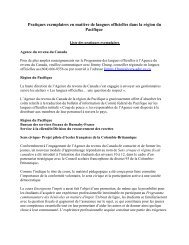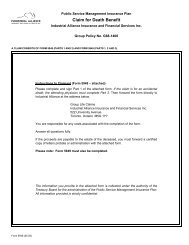Guide for the Development of Results-based Management and ...
Guide for the Development of Results-based Management and ...
Guide for the Development of Results-based Management and ...
Create successful ePaper yourself
Turn your PDF publications into a flip-book with our unique Google optimized e-Paper software.
RMAF <strong>Guide</strong> August, 2001In prioritising <strong>the</strong> evaluation issues, managers need to take into account <strong>the</strong>ir risk managementconsiderations <strong>and</strong> determine <strong>the</strong> most important areas <strong>for</strong> attention. The process <strong>of</strong> developing aninventory <strong>of</strong> possible evaluation questions <strong>and</strong> <strong>the</strong>n determining those <strong>of</strong> highest priority helps to ensurethat <strong>the</strong> final set <strong>of</strong> evaluation questions both addresses key in<strong>for</strong>mation requirements <strong>of</strong> managers, <strong>and</strong> ispractical to implement in terms <strong>of</strong> timing <strong>and</strong> resourcing. It also allows <strong>for</strong> <strong>the</strong> documentation <strong>of</strong> allevaluation issues which were considered so that <strong>the</strong>re is a record <strong>of</strong> those issues contemplated butdetermined to be <strong>of</strong> lower priority <strong>for</strong> an evaluation <strong>of</strong> <strong>the</strong> policy, program or initiative.c. ProductThe product <strong>of</strong> this phase <strong>of</strong> RMAF development is a set <strong>of</strong> issues <strong>and</strong> questions which, when answered,will allow <strong>for</strong> a thorough assessment to be made <strong>of</strong> <strong>the</strong> relevance, success <strong>and</strong> cost-effectiveness <strong>of</strong> apolicy, program or initiative, <strong>and</strong> provide in<strong>for</strong>mation to managers to guide <strong>the</strong>ir decision-making.3.4.2 Identification <strong>of</strong> Data Requirementsa. PurposeThe next step in <strong>the</strong> development <strong>of</strong> an evaluation strategy is to clearly identify <strong>the</strong> key pieces <strong>of</strong>in<strong>for</strong>mation that need to be collected in order to answer each evaluation question. In particular, it isimportant to identify at this stage any evaluation data requirements which rely on <strong>the</strong> ongoing collection<strong>of</strong> in<strong>for</strong>mation, to ensure that <strong>the</strong> necessary data are available at <strong>the</strong> time <strong>of</strong> any evaluation study.b. ProcessThe key tools that are required to identify <strong>the</strong> evaluation data requirements have already been created atthis stage <strong>of</strong> <strong>the</strong> development <strong>of</strong> <strong>the</strong> <strong>Results</strong>-<strong>based</strong> <strong>Management</strong> <strong>and</strong> Accountability Framework, namely<strong>the</strong> set <strong>of</strong> evaluation issues <strong>and</strong> questions.The process to identify <strong>the</strong> data requirements involves going through <strong>the</strong> set <strong>of</strong> evaluation issues <strong>and</strong>associated questions <strong>and</strong> determining what pieces <strong>of</strong> in<strong>for</strong>mation would be required in order to be able toanswer <strong>the</strong> questions <strong>and</strong> address <strong>the</strong> evaluation issues. At this stage <strong>of</strong> <strong>the</strong> process, <strong>the</strong> focus is on <strong>the</strong>24


